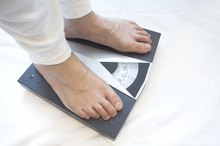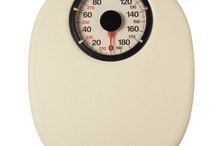How Long Will it Take Me to Lose 10 lbs. on a 1,500-Calorie Diet?
Reducing caloric intake and setting goals are two parts of successful weight loss. Reducing caloric intake to 1,500 calories a day will result in weight loss for many people. The requirements for weight loss are basic. If you want to lose 10 pounds on a 1,500-calorie diet, you must understand how weight loss occurs and what you can do to achieve it.
Facts
There are 3,500 calories in 1 pound of fat. Every day your body requires calories to operate. If you consume fewer calories than your body needs, you will lose weight. The relationship between the number of calories you need and the number you consume is what determines you rate of weight loss. A 1,500-calorie diet will produce different results in different people, based on their individual metabolic rates, caloric needs and amount of exercise.
- There are 3,500 calories in 1 pound of fat.
- A 1,500-calorie diet will produce different results in different people, based on their individual metabolic rates, caloric needs and amount of exercise.
Basal Metabolic Rate
How Many Calories to Lose 40 Pounds?
Learn More
Your basal metabolic rate, or BMR, is the most basic predictor of your daily caloric needs. Based on your age, height, weight and gender, your BMR is the number of calories your body needs in one day to maintain its current weight, assuming no exercise or activity. Your BMR's relationship to a 1,500-calorie diet will affect how quickly you can lose 10 pounds. For example, if your BMR requires you to consume 2,000 calories per day to maintain weight, a diet of 1,500 calories will allow you to cut 500 calories per day from your diet, which is the equivalent to a weight loss of 1 pound per week.
- Your basal metabolic rate, or BMR, is the most basic predictor of your daily caloric needs.
- Based on your age, height, weight and gender, your BMR is the number of calories your body needs in one day to maintain its current weight, assuming no exercise or activity.
Exercise
Every time you exercise, your body burns additional calories in order to provide for your increased energy requirements. When your body runs out of calories, it begins to burn fat. You must take into account any calories you burn with exercise when planning your diet. For example, if you are maintaining a 1,500-calorie diet and complete exercise that burns 300 calories, you can consume 1,800 calories. The 300 calories burned through exercise have to be replaced with food, in order to maintain a consistent caloric intake.
- Every time you exercise, your body burns additional calories in order to provide for your increased energy requirements.
- The 300 calories burned through exercise have to be replaced with food, in order to maintain a consistent caloric intake.
Caloric Intake
4-3-2-1 Diet
Learn More
While it may seem simple, many people do not understand the basics of weight loss related to caloric intake. Every day your body requires a certain number of calories in order to survive. Your caloric needs are determined by numerous factors, including your activity level, age and body type. The number of calories your body needs represents a distinct line. Eat more calories than you need and you gain weight; eat less and you lose weight. A good diet plan is equal to 1 pound of weight loss per week. This requires cutting 500 calories from your daily diet. Achieve this by instituting a 1,500-calorie diet with regular exercise.
- While it may seem simple, many people do not understand the basics of weight loss related to caloric intake.
Considerations
The USDA and the National Institutes of Health recommend that you do not engage in any weight-loss program that causes you to lose more than 2 pounds in a week. Avoid any diets that advertise rapid weight loss or use over-the-top marketing claims. Choose a diet plan that is consistent and effective. Losing 2 pounds a week adds up quickly, allowing you to achieve your target weight safely and permanently.
- The USDA and the National Institutes of Health recommend that you do not engage in any weight-loss program that causes you to lose more than 2 pounds in a week.
Related Articles
References
- MedlinePlus: Weigh Control
- Harvard Health Publications: Calorie Counting Made Easy
- U.S. Department of Health and Human Services and U.S. Department of Agriculture. 2015–2020 Dietary Guidelines for Americans. 8th Edition. December 2015.
- Hall KD, Chow CC. Why is the 3500 kcal per pound weight loss rule wrong?. Int J Obes (Lond). 2013;37(12):1614. doi:10.1038%2Fijo.2013.112
Writer Bio
Patrick Hutchison has been doing freelance work since 2008. He has worked as a physical therapy aide and as a writer for various websites including Destination Guides and several travel-related companies. Hutchison has a Bachelor of Arts in history and anthropology from the University of Washington.









